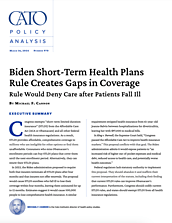In 2023, the Biden administration proposed to require both that insurers terminate all STLDI plans after four months and that insurers not offer renewals. The proposal would cause STLDI enrollees who fall ill to lose their coverage within four months, leaving them uninsured for up to 12 months. Estimates suggest it would cause 500,000 people to lose comprehensive health insurance. A similar requirement stripped health insurance from 61‐year‐old Jeanne Balvin between hospitalizations for diverticulitis, leaving her with $97,000 in medical bills.
In King v. Burwell, the Supreme Court held, “Congress passed the Affordable Care Act to improve health insurance markets.” This proposal conflicts with that goal. The Biden administration admits it would expose patients to “an increased risk of higher out‐of‐pocket expenses and medical debt, reduced access to health care, and potentially worse health outcomes.”
Federal regulators lack statutory authority to implement this proposal. They should abandon it and reaffirm their current interpretation of the statute, including their finding that current STLDI rules can improve Obamacare’s performance. Furthermore, Congress should codify current STLDI rules, and states should exempt STLDI from all health insurance regulations.



